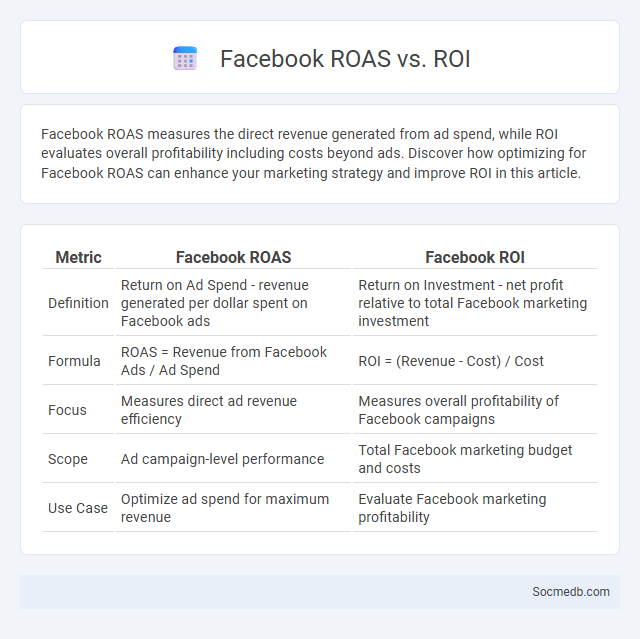
Photo illustration: Facebook ROAS vs ROI
Facebook ROAS measures the direct revenue generated from ad spend, while ROI evaluates overall profitability including costs beyond ads. Discover how optimizing for Facebook ROAS can enhance your marketing strategy and improve ROI in this article.
Table of Comparison
| Metric | Facebook ROAS | Facebook ROI |
|---|---|---|
| Definition | Return on Ad Spend - revenue generated per dollar spent on Facebook ads | Return on Investment - net profit relative to total Facebook marketing investment |
| Formula | ROAS = Revenue from Facebook Ads / Ad Spend | ROI = (Revenue - Cost) / Cost |
| Focus | Measures direct ad revenue efficiency | Measures overall profitability of Facebook campaigns |
| Scope | Ad campaign-level performance | Total Facebook marketing budget and costs |
| Use Case | Optimize ad spend for maximum revenue | Evaluate Facebook marketing profitability |
Understanding Facebook ROAS: Definition and Importance
Facebook ROAS (Return on Ad Spend) measures the revenue generated from your Facebook advertising relative to the amount spent, providing a clear metric of campaign effectiveness. Understanding this key performance indicator helps optimize ad budgets, improve targeting strategies, and maximize profits by focusing on high-performing ads. You can leverage Facebook ROAS data to make informed decisions and enhance your overall marketing ROI.
What Is ROI in Facebook Advertising?
ROI in Facebook advertising measures the return on investment by comparing the revenue generated from ad campaigns to the cost spent on those ads. It is calculated by dividing the net profit from Facebook ads by the total advertising cost, then multiplying by 100 to get a percentage. Tracking ROI helps businesses optimize ad targeting, budget allocation, and campaign strategies for better performance and higher profitability.
Key Differences Between ROAS and ROI
ROAS (Return on Ad Spend) measures the revenue generated specifically from your social media advertising campaigns, offering a precise insight into campaign efficiency by comparing ad spend to attributable sales. ROI (Return on Investment), however, evaluates the overall profitability by considering all costs and returns beyond just ad expenditure, providing a broader perspective on your social media marketing effectiveness. Understanding these key differences helps you optimize budget allocation and improve financial outcomes for your business.
How Facebook Calculates ROAS
Facebook calculates Return on Ad Spend (ROAS) by dividing the total revenue generated from ads by the amount spent on those ads within a specified period. This calculation leverages Facebook's pixel and conversion tracking tools to attribute sales and conversions directly to ad campaigns. Accurate ROAS measurement enables advertisers to optimize their budgets by identifying the most profitable ads and audience segments on the platform.
Interpreting ROI in Digital Marketing Campaigns
Measuring the ROI of social media in digital marketing campaigns requires analyzing metrics such as engagement rates, click-through rates, and conversion tracking to quantify the impact on sales and brand awareness. You must integrate data from multiple platforms like Facebook, Instagram, and LinkedIn to get a comprehensive view of campaign performance and optimize budget allocation. Using advanced analytics tools and attribution models helps determine which social media activities drive the highest return on investment.
The Role of Reporting in Facebook Ad Performance
Effective reporting in Facebook ad performance provides critical insights into your campaign metrics, including click-through rates, conversion rates, and audience engagement. By analyzing detailed reports, you can optimize ad targeting, budget allocation, and creative content to maximize return on investment. Your ability to interpret these data points directly influences the success and scalability of your social media advertising strategy.
Metrics to Track for Accurate Facebook Reporting
Tracking key metrics such as engagement rate, reach, and click-through rate is essential for accurate Facebook reporting. Monitoring these metrics helps you understand audience behavior, measure content effectiveness, and optimize your social media strategy. Consistently analyzing your Facebook Insights data allows you to make informed decisions that drive better campaign performance and growth.
Common Mistakes: ROAS vs ROI in Facebook Reports
Confusing ROAS (Return on Ad Spend) with ROI (Return on Investment) in Facebook reports is a frequent error that can mislead your advertising strategy. ROAS measures revenue generated per dollar spent on ads, while ROI accounts for overall profit by including all costs beyond ad spend. Understanding this distinction allows you to accurately evaluate campaign performance and optimize your social media marketing budget.
Best Practices for Analyzing Facebook Ad Data
Analyzing Facebook ad data requires tracking key performance indicators such as click-through rates (CTR), cost per click (CPC), and conversion rates to measure campaign effectiveness and optimize ROI. Utilize Facebook Ads Manager's breakdown features to segment data by demographics, placements, and time intervals for deeper insights into audience behavior. Implement A/B testing with varied creatives and targeting parameters to identify the highest-performing ads and refine strategies based on data-driven results.
Choosing the Right Metric: When to Use ROAS, ROI, or Reporting
Choosing the right metric for social media campaigns depends on your marketing objectives and data accessibility; ROAS (Return on Ad Spend) is ideal for evaluating direct revenue generated from specific ads, while ROI (Return on Investment) provides a broader view of profitability, including all related costs. Reporting metrics such as engagement rates, impressions, and click-through rates offer insight into audience interaction and campaign reach but may not directly correlate with financial performance. Understanding when to prioritize ROAS, ROI, or engagement metrics ensures accurate measurement and optimization of social media marketing strategies.
 socmedb.com
socmedb.com